
|
xTuple ERP Reference Guide |
To add new components to a Bill of Materials, select the NEW button. The following screen will appear:
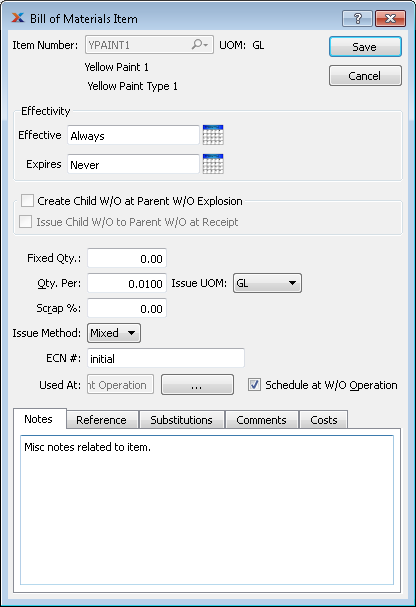
Bill of Materials component Items must have an Item Site defined to be valid.
When adding a new component Item to a Bill of Materials, you are presented with the following options:
Enter the Item Number of the Item you want to add to the Bill of Materials.
Inventory Unit of Measure.
Description of Item.
Specify the component's effectivity, using the following parameters:
The system enables you to specify when a component can be used in a Bill of Materials. For example, the company's engineering department may be working on a new design for an existing Item—but that new design will not be available for use until a given date in the future. In this case, you can specify a future "effective" date to indicate when the component will be available for use.
The system also enables you to specify when a component is planned to be obsoleted from (i.e., no longer used in) a Bill of Materials. As mentioned above, the company's engineering department may be working on a new design for an existing Item—but that new design will not be available for use until a given date in the future. In this case, the old component Item must be marked for "expiration" on the date when the new Item becomes effective. Setting this parameter will instruct the system to stop using the specified component on the date entered into this field.
Select to create Work Orders for manufactured components when their parent Items are exploded. This option applies only to manufactured Items appearing as components on a Bill of Materials. If selected, a Work Order will automatically be created for the manufactured component when the parent Item is exploded. The impact on Work Order numbers will be visible. For example, a "-1" will be appended to the parent level Work Order and a "-2" to the child level Work Order—as in, #1061-1 and #1061-2. If this option is not selected, a child Work Order will not be created when the parent Item is exploded.
The "Create Child W/O at Parent W/O Explosion" option will cause the creation of lower level Work Orders BOTH at Work Order explosion and also during the explosion that takes place during Master Production Scheduling (MPS) and Material Requirements Planning (MRP) runs.
Select to have the completed Item (i.e., subassembly) issued to the parent Work Order at the point when production for the child Work Order is posted.
Use this option to specify a "flat" quantity of material required that is independent of the total quantity produced on a batch or Work Order. For example, tooling Items added to a Bill of Materials generally have a fixed quantity regardless of the total quantity of finished goods produced. Batch size does have an impact on the costing for fixed quantity Items, however. For example, if the parent Item's batch size is 100 and the cost of the fixed quantity Item is $100, then the fixed Item's cost should be distributed across the batch, as in the following: ((1/100) * $100) = $1.
To ensure fixed quantity Item costs are distributed accurately across an entire batch, make sure you select the "Fractional" option on the Item master for the Item. If the Item is not fractional, then the batch size conversion may not prorate the fixed quantity costs accurately.
Specify the quantity of the component Item required per Bill of Materials. This is a required field.
Specify the Unit of Measure (UOM) you want to use when issuing Item quantity to Work Orders. Unless you specify an alternate UOM, the Inventory UOM will be used by default.
Number entered should represent a percentage of material quantity that is additionally consumed as Scrap. This is a required field.
Using the "Create Child W/O at Parent W/O Explosion" option can greatly simplify the processing of Work Orders. If this option is not selected, child Work Orders will need to be created independently.
Method: Select one of the available issue methods:
Select if you want the component Item to be issued to Work Orders by a specific material issue transaction. Because a specific material issue transaction must be used, "Push" Items enable you to monitor material usage variances. Standard issue quantities are not automatically backflushed to Work Orders, as is true for "Pull" Items. If a component Item uses the "Push" issue method, you must manually issue quantities to Work Orders.
Select if you want the component Item to be issued to Work Orders by a material backflush. "Pull" Items are automatically issued to Work Orders when Work Order Production is posted. Using the "Pull" issue method saves time, since materials do not need to be manually issued to Work Orders by a specific material issue transaction.
Select if you want the component Item to take upon itself the issue method applied to it initially—that is, either "Pull" or "Push." Assigning the "Mixed" issue method to a component Item gives you the flexibility of deciding on a Work-Order-by-Work-Order basis whether you want to assign the "Pull" or "Push" method to the component Item.
You can define a default issue method for new Bill of Materials component Items at the system level.
Enter the Engineering Change Notice Number—if applicable—for the specified component Item.
BOM-defined Substitutions are the only Substitutes which may be implemented during Work Order processing. To substitute a component Item on a Work Order, use the "Substitute" option found on the right-click menu of the Maintain Work Order Material Requirements screen.
Specify which Operation the component is used at. Using the lookup feature located to the right of the field, select a Bill of Operations sequence number to identify which Operation the component is used at. Linking a component with an Operation will have certain effects. First, when posting Operations, components that are linked to a given Operation will be backflushed if the issue method for the components is either "Pull" or "Mixed" and the Operation is set to Auto Issue components. Secondly, Work Order paperwork, such as Routings, will show the relationship between linked Work Order Material Requirements and Work Order Operations.
If an Operation is expired, the link between the Operation and the component Item will be removed.
Select to indicate that this component is not due until the Work Order Operation that will consume it is scheduled to begin. The scheduling of Operations is handled by the Execution Day indicator on the Bill of Operations item screen. For example, let's say we have an Operation with an Execution Day = 5. This means the Operation is scheduled to begin five days after the start date of the Work Order. Components scheduled with this Operation are due the day before the Operation starts—that is, on day four after the Work Order start date—to ensure they will be available when the Operation is scheduled to begin. If this option is not selected, then the component scheduling will be governed by the start and due dates set on the Work Order header.
Enter additional Notes related to the Item.
To add Reference information related to a BOM Item, select the "Reference" tab. The following screen will appear:

The Reference field can be used to identify any additional attributes associated with an Item.
To add Substitution information related to a BOM Item, select the "Substitution" tab. The following screen will appear:
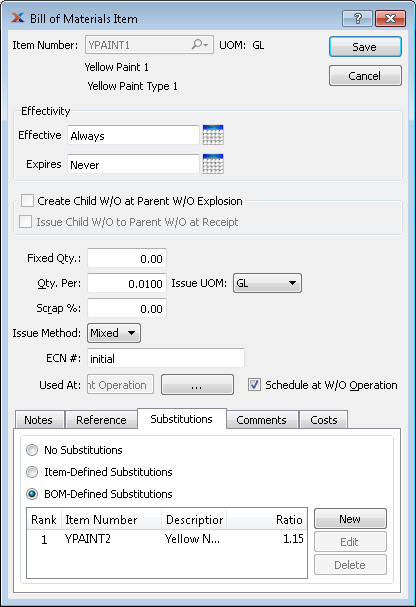
Choose one of the following Item Substitution options:
Select if no Substitutions exist for the component Item.
Select if Substitutions are defined on the Item master for the component Item. Selecting this option will not cause Item-defined Substitutions to display here. You are simply indicating that Item master level Substitutions do exist.
Select to define Item Substitutions at the Bill of Materials level.
To ensure Availability, a BOM-defined Substitution must be located in the same Site as the component Item it replaces. If the Substitute is located in a different Site, it will not be available for substitution.
To create a new BOM-defined Substitution, select the NEW button. The following screen will appear:
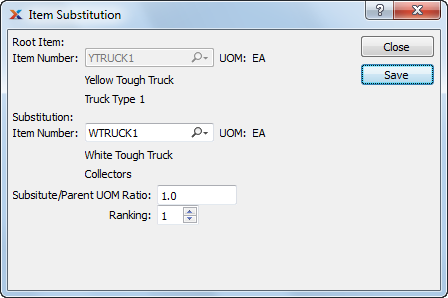
When adding a new BOM-defined Substitution, you are presented with the following options:
Displays Item Number of specified component Item.
Inventory Unit of Measure.
Enter the Item Number of the Substitute Item.
Inventory Unit of Measure.
Indicate the ratio between the Issue UOM for the specified BOM Item and the corresponding Issue UOM for the Substitute Item.
Select a number using the arrow buttons, or manually enter a value up to a maximum of 9. Enter the specified ranking order of the Item Substitute. You may assign the same ranking to multiple Items, if this is appropriate.
To add Comments to a component Item, select the "Comments" tab at the bottom of the "Bill of Materials Item" screen. The following screen will appear:
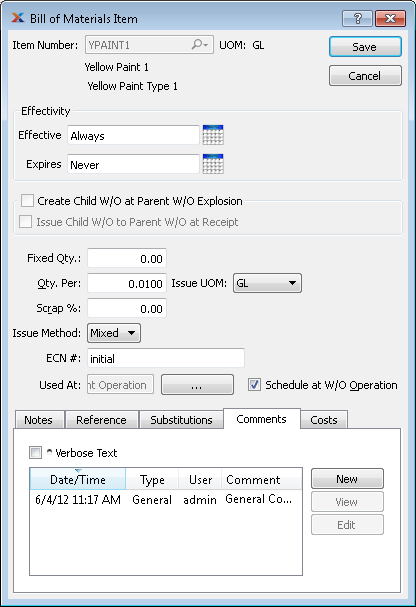
When adding or reviewing Comments, you are presented with the following options:
Select to display all Comments in the list in an expanded view which includes the entire text of each Comment. To edit a Comment, simply select the "Edit" link next to the Comment. That link will not be shown for Changelog Comments, which can't be edited. If the "Verbose Text" option is not selected, the Comment list will display only header level information for each Comment.
Display lists Comments related to the record.
The following buttons are available:
Opens screen for creating a new Comment.
Highlight a Comment and then select this button to reach a read-only view of the "Edit" screen.
Enables you to edit highlighted Comments—as long as the Comments are not "ChangeLog" Comments. ChangeLog Comments are system-generated and may not be edited. The edit screen is the same as that for creating a new Comment—except that when editing, the fields will contain Comment information. Double-clicking on a Comment will also bring you to the editing screen.
To enter a new Comment, select the NEW button. The following screen will appear:

Select a Comment Type from the drop-down list to classify the Comment. This is a required step. Comment Types may be system-defined (i.e., "ChangeLog" and "General") or user-defined, as described in Section 13.2.2, “Comment Types”. Once you have specified a Comment Type, begin typing your Comment in the main text area. The text area features word-wrapping and scroll-bar support for longer Comments.
The following buttons are unique to this screen:
Select to show the complete list (i.e., "thread") of Comments associated with the record. To hide the list, simply select the SHOW MORE button again. The Comment thread will show the most recent Comment first.
To view or maintain the current standard costs for the selected item, select the "Costs" tab at the bottom of the "Bill of Materials Item" screen. The following screen will appear:

When opening the Bill of Materials item Costs, you are presented with the following options:
Select this option to manually edit the current standard costs of the item. If this option is not selected, a read only list of the current standard costs for the item is displayed.
If this option is unchecked after the costs have been changed, the list will revert to displaying standard costs.
A list of the costing elements with current standard cost of the Bill of Material item is displayed.
To link a Bill of Materials component to a Bill of Operations Item, select the lookup feature located to the right of the "Used At" field. The following screen will appear:
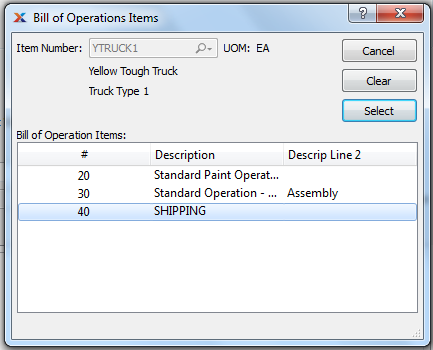
When linking Bill of Materials components to Bill of Operations Items, you are presented with the following options:
The component Item selected on the Bill of Materials screen will display here.
Inventory Unit of Measure.
Display lists Bill of Operations Items for the same manufactured Item whose Bill of Materials is being specified. Highlight the Operation you want to link the Bill of Materials Item to, then hit the SELECT button.
The following buttons are unique to this screen:
Removes the link between a Bill of Materials component and a Bill of Operations Item if such a link has been made.
Links the Bill of Operations Item to the specified Bill of Materials component. Highlight the desired Bill of Operations Item before selecting the SELECT button.
On a Bill of Materials, if the parent Item is a configured Item (i.e., configured Job Item or Reference Item), then you will have the option to link BOM Items to specific parent Item Characteristics. For example, let's say the parent Item has a Characteristic for paint finish with the values "Flat" and "Glossy". At the BOM Item level, you can specify whether the BOM Item goes with "Flat" or "Glossy". If you choose "Glossy" to associate with the BOM Item, then that means the BOM Item will be included as a material requirement whenever Orders call for the "Glossy" version of the parent Item. If no Characteristic association is made at the BOM Item level, then the BOM Item will always appear on Work Orders—regardless of the parent-level configuration selection. To associate Characteristics with a BOM Item, select the "Configuration" tab. The following screen will appear:
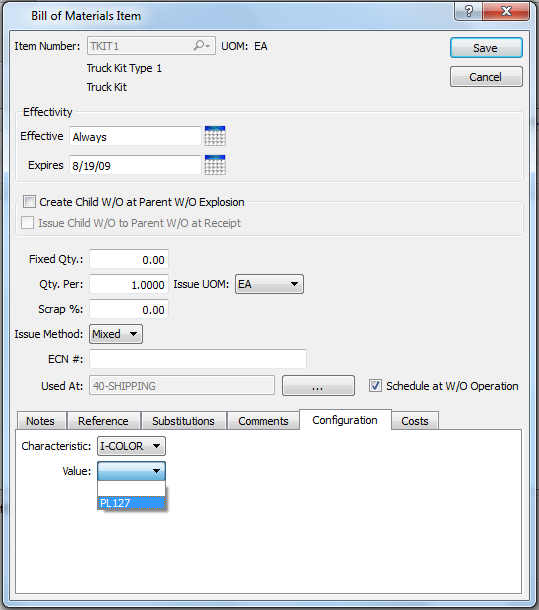
You can learn more about Item configuration in xTuple ERP by reading the Assemble to Order (ATO) Configuration Topic.
When associating Characteristics with a BOM Item, you are presented with the following options:
Select a Characteristic from the list of Characteristics. These Characteristics are Item Characteristics defined on the Item master for the parent Item on the Bill of Materials. Linking parent Characteristics to child BOM Items means the child Item will be included as a material requirement whenever Orders call for the same parent Item Characteristic.
Enter a value to associate with the selected Item Characteristic.